Aidha Cader shares her journey as she walks through enchanted doors into the mystical cities of the Arabian nights
We are going where, exactly?” asked my children “Double landlocked, bordering Afghanistan, ex- Soviet state, is this for real?” they continued to whine. But if you are like me, wanting to experience the fable tales of the ancient Silk Road, picturing drool-worth Islamic architecture of blue domed mosques and mosaic covered walls in medieval oasis cities, where majestic minarets stand like lighthouses of the desert, welcoming travellers who wonder across its arid wilderness, snow capped mountains and fertile valleys, then Uzbekistan is the place to go.
Chequered Past
Uzbekistan, a young country having received its independence in 1991 from the then fragmenting Soviet Union is nevertheless, steeped in history. It has faced the brunt of the world’s most formidable conquers, Alexander the great, the Arabs, Genghis Khan and in the 14th century tyrant Amir Timur, who created an empire that stretched from Delhi to Moscow, with Samarkand as his capital. Positioned at the heart of the Silk Road between China and Rome, it grew rich by the camel laden caravans carrying goods of silk, paper, glass, ceramics, gunpowder, spices and slaves. At the crossroads of culture, the cities of this region transformed into centres of learning where science, technology philosophy and religion flourished. By the 19th century the Uzbek people and their cities were immersed into the Romanov Empire and later faced Lenin’s Bolshevik revolution. Eventually, as the Red army cloaked the entire region, it lay hidden behind Stalin’s Iron curtain.

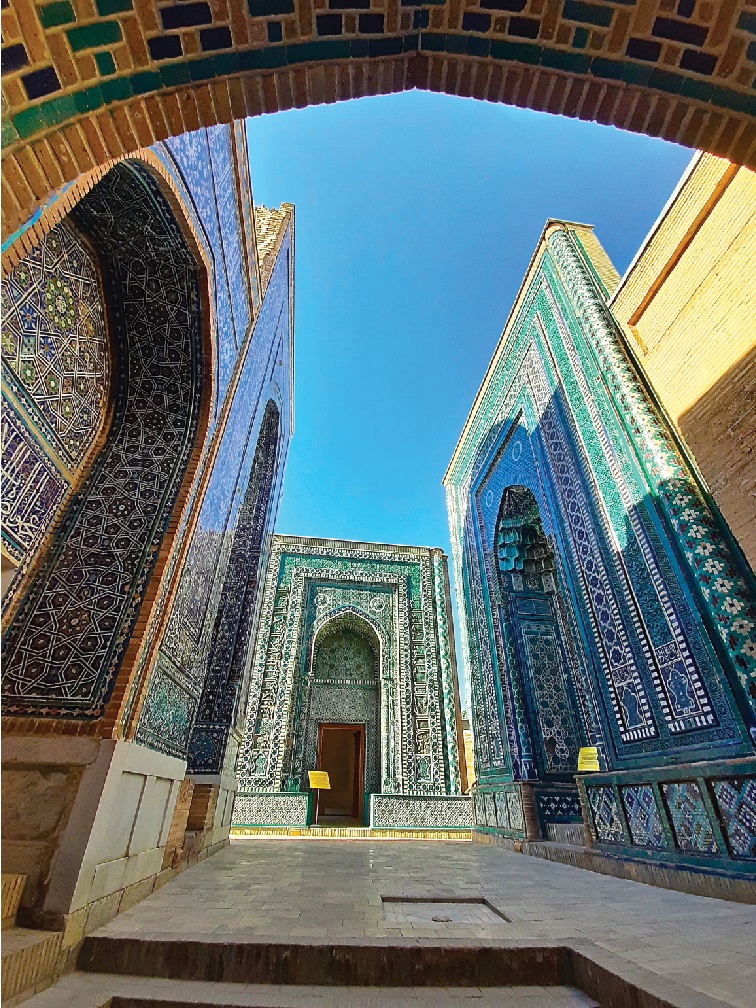
Monumental Samarkand
After Timur’s relentless battles across Asia he brought home the finest artisans, craftsman and architects and built colossal architecture with his war booty. The Bibi Khanum mosque in Samarkand with its large ribbed blue dome and enormous entrance portal, built for his Chinese wife after his conquest of India, is one such project. The mosque was the largest in medieval Islam and defied architectural technology at its time, which let to its gradual despair. Registan Square another medieval jewel is at an unprecedented scale. As we stepped into the centre all around us loomed imposing ornate portals, patterned minarets and glistening cupolas, a dizzying display of monumental extravagance. When Ibn Battuta visited the city in 1330, he described it as “one of the greatest and the most perfect in beauty”. He was right. The square is surrounded on three sides. The Ulugbek Madrasah built by Timur’s grandson in 1419 has a front facade depicting stars, reflective of his passion for astronomy. The two minarets at the corners lean inwards and the dent on its portal, owing to the earthquakes feels like a welcome stroke of imperfection to an otherwise unimaginable achievement of medieval architecture. The Sher-Dor Madrasah built in the 17th century with its mosaic tile tigers, deer and the sun, are rare imagery within iconoclastic Islamic architecture. The Tilla-Kari Mosque decorated with inlaid mosaic in geometric and floral exterior is a mere comparison to its golden enclave, inside. My eyes followed the gold floral motifs that snake up the walls onto its illustrious dome, where they bloom and intertwine, creating multiple layers of infinity. The following day, we visited the Gur-Emir mausoleum, the final resting place of Timur, his son and grandson Ulugbek. The ceiling and walls dazzle in gold decoration that exudes a sense of power as his onyx tomb lies at the feet of his teacher and saint Sayyid Baraka. On the outskirts of Samarkand is the Shah-i-Zinda, a Timurid era necropolis consisting of mausoleums for his family, court dignitaries and the Prophet Muhammad’s cousin, Qusam ibn Abbas. Like the many tales of the region, this too is shrouded in myth and mystery. We walked up the stairs through entrance leading to the narrow street where a beautiful cluster of ad-hoc tombs swathed in waves of blue that blend in with the sky.
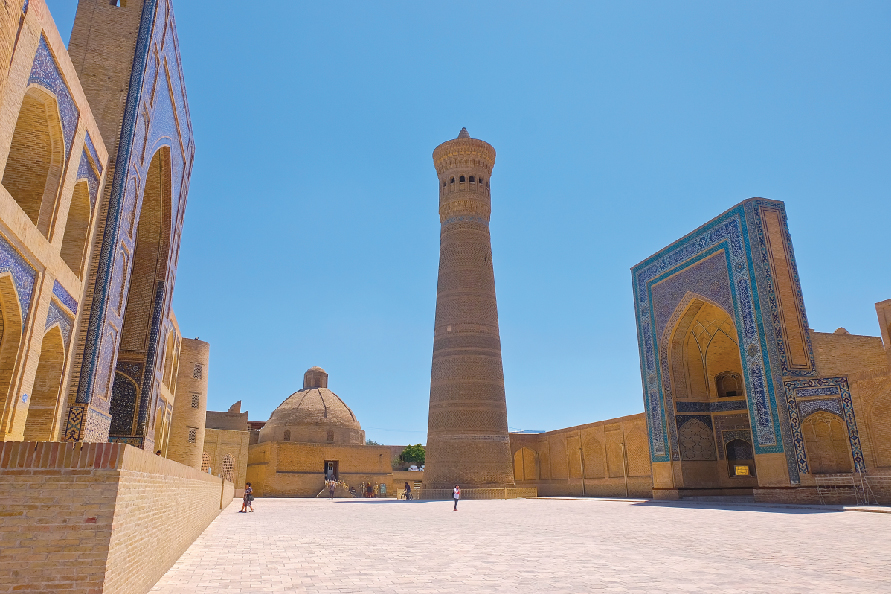
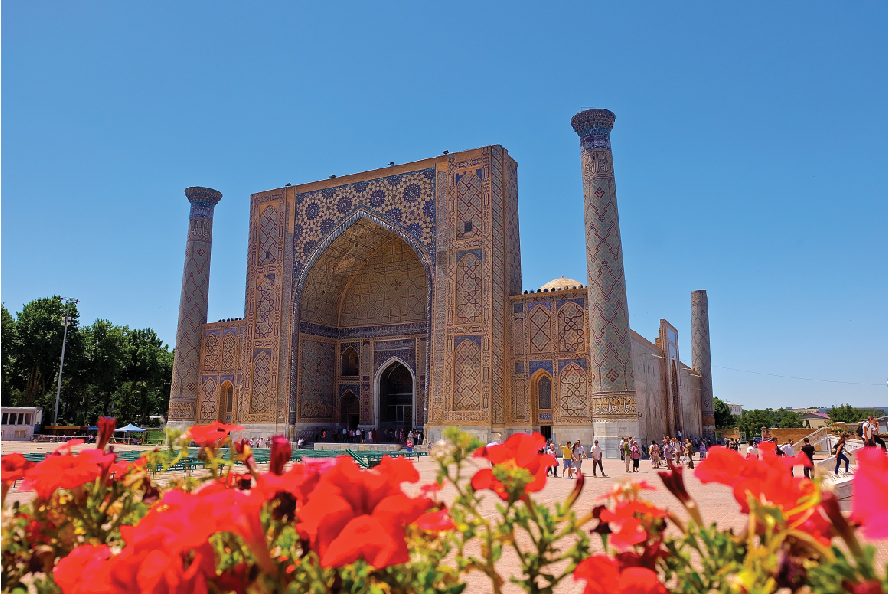
The walled city of Khiva
This 10th century well-preserved open-air museum city looks straight out of a Game of Thrones set. Situated between the Kizyl-kum and Kaza-kum desert, this oasis town has attracted traders, travellers and conquerors alike. We strolled around the labyrinth of mud-walled alleys, admiring the swirling patterns etched on to its wooden doors that lead to multiple museums, mosques and madrasahs. The Jumma Mosque, with perfectly lined up rows of 218 uniquely carved columns of elm, some of which date back to the 10th century is like a mystical woodland. The 17th century fortress Kunya Ark, the seat of the Khans consists of turquoise and dark-blue tiled palaces with gilded harems and mosques. The Islom-Hoja Minaret, pretty much visible from anywhere in the city with its bands of turquoise, white and red tiling is Uzbekistan’s highest minaret. The iconic Kala Minor Minaret, with its large base only to rise up to a third of its envisioned height remains unfinished due to the untimely death of the then, Khiva Khan. As the sun hung low we climbed up the sandstone rooftop of the Kutlug Murad-inak madrasah to watch the sky turn pink, casting its hue over the panoramic tile glazed city, which looked like a painstakingly decorated masterpiece.


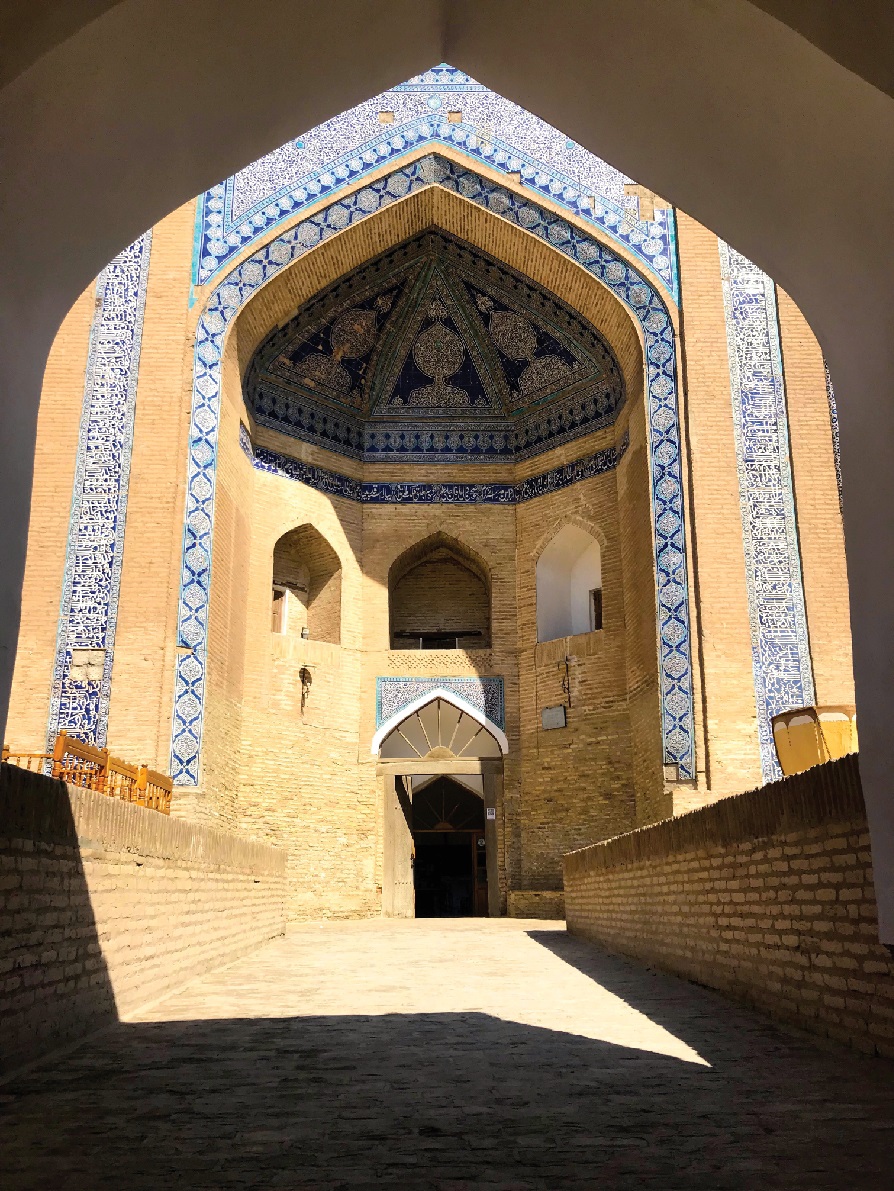
Bukhara, the Dome of Islam
With over a hundred Islamic monuments, Bukhara was the spiritual heart of the medieval Islamic empire. As we walked across the old city our point of vision fell on its greatest survivor, the Kalyan minaret. Built in 1121 by the Kara-khanid ruler, the minaret was the only monument spared by Genghis khan as he touched the city in 1220. From its octagonal base it tapers into the heavens through ten bands of carved brick and delicate majolica tile work. Po-i-Kalyan, which means ‘the foot of the great’, also has the 15th century Kalyan Mosque with its 288 domed galleries encircling the large courtyard and the Mir-i-Arab Madrasah with its two blue domes, mosaic tiles, stone and baked bricks decorated façade within its complex. Through its jali (net-like) window I peeped into the open courtyard. Here students were busy studying the Quran and for a moment it felt as though I had stepped back in time. A sense of poetic and wistful charm of the old and authentic Silk Road city character still holds true in Bukhara.
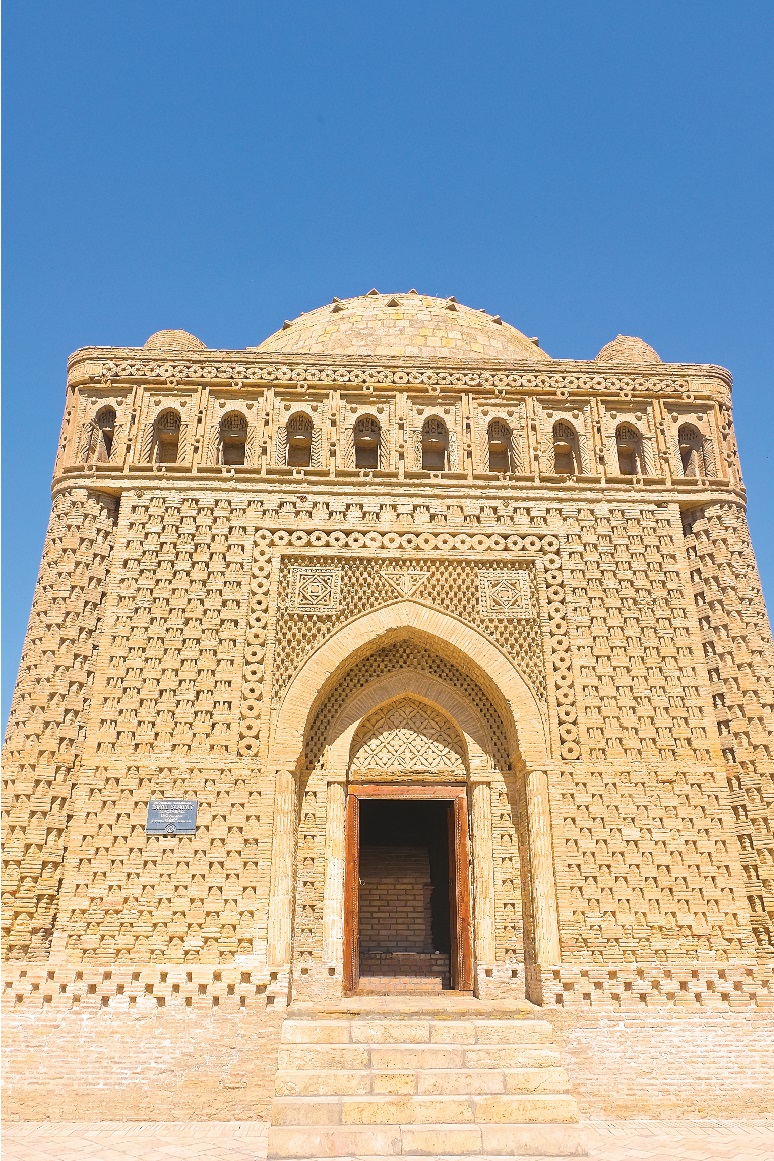

Enigmatic charm
As dusk broke, we sat at the teahouse in Lyab-i- Hauz Square, in the centre of the old town in Bukhara. Weeping willow and mulberry trees line the ponds where fountains, open-air cafes, parks and three iconic madrasahs enclose its surrounding, making this the most picturesque site in the city. The local tourists in their traditional garments and fancy headgear were eager to take photographs with us, all the while flashing their ‘golden-toothed’ smiles. Sipping our coffee and people watching whilst gazing at its greenish ponds, our guide breaks the silence, “before we had hundreds of such pools, but the Russians closed most of it,” she said in despair. The disappearance of the ponds came with the loss of its local resident, the storks. For centuries they had been part of the skyline, now only to be replaced by tacky concrete versions. The alleyways that run across the old city like veins are filled with young Uzbeks bustling along, while older men play Dominoes seated on daybeds beside the canals, sipping tea.

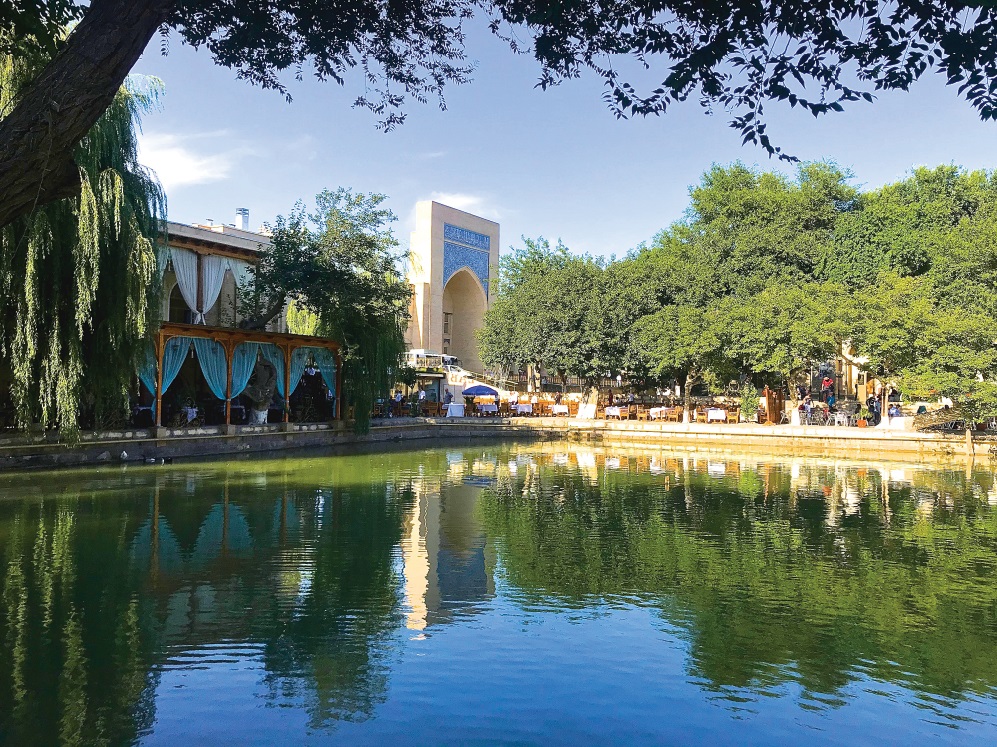
A window into their soul
Central Asia’s most populous country Uzbekistan is dotted with numerous tombs. A region steeped in Sufism, it is on a revival after decades of communist suppression. For the millions of Uzbeks, these are sacred places and the government is keen to cash in on it as the country opens up after decades of isolationist and authoritarian rule. Be it the Imam Al-Bukhari, the Baha-ud-Din Naqshband, or the Sayf ad-Din al-Bokharzi or the countless other mausoleums that have been re-vamped to cater to the flux of pilgrims and tourists alike. Inside the Pahlavan Mahmud Mausoleum in Khiva a steady flow of newly wedded couples enter through. As the imam recites a few verses from the Quran in a melodious tone, it echoes inside the beautifully blue tiled chamber creating sense of sublime calm. Uzbeks still hold on to some of its Zoroastrian and Mongol traditions. “Couples are blessed at their wedding with sacred fire and the celebration of Nowruz is popular,” explains our guide. This assimilation is also visible in its early Islamic architecture, the 10th century Samanid mausoleum and the Magok-i-Attari Mosque in Bukhara incorporates both Zoroastrian and Islamic motifs.
Historic relics and legends
In Tashkent’s old city is the 16th century Hazrat Imam Complex that houses the Caliph Uthman’s Quran. In a climate controlled glass case, its ancient pages made of gazelle are pried open like the wings of a butterfly with clear Kufic text, resonating as it did in the 8th century. On the page are the dried bloodstains that hold witness to its history. Seized by Timur after his conquest of Baghdad in 1401 it was originally housed on the marble edifice at the Bibi Khanum mosque in Samarkand. Local lore has it that any woman who crawls under the stand will be blessed with children. Another loot from Baghdad is the leg bone of the Prophet Daniel reburied in a mausoleum for good fortune by Timur. Also in Samarkand is the Hazrat Khizr Mosque, the mystical saints of the traveller, who mentored the Prophet Moses. In Bukhara is the Chashma-Ayub Mausoleum that houses well of Prophet Job and the water is believed to contain healing properties from which we also filled up our bottles, hoping to stay healthy and hydrated.
Pristine landscape
To understand the vastness of the Central Asian nomadic steppe is to travel by road. Our eight-hour road trip across the saffron sands of the Kizyl-kum desert to the border of Turkmenistan where the Oxus River forms a natural boundary epitomises this land. As we neared the ancient city of Bukhara, cotton farms took over and heaps of melons dotted the roadsides. The landscape was vastly different when we drove to Samarkand. Here, the silhouette of the Bactrian camels on a hilltop looked on as wild horses ran free across the meadows and grazing sheep feasted on its rich pastures. The unspoiled peaceful life of the villagers carrying their goods on donkey carts pass by. After days of ticking our checklists of endless monuments, we switched gears and drove up to the Zarafshan mountain range. As dusk drew closer we stopped at the Takhta-Karacha Pass and gazed over the picturesque view of snow-capped mountains on the distant horizon.
Re-masking
Through a bizarre twist in legacy, a figure once so feared and vilified, completely forgotten under Soviet rule, has now emerged as the symbol of the new state. This new and improved version of Timur as a humanist visionary, a political leader who forged a vast empire out of feuding petty kingdoms is refashioning the narrative. Streets and squares are named after him and former Marxist statues of Lenin and Stalin have been pulled down to be replaced by the Turco-Mongol, Timur. Throughout the country, newly wedded couples celebrate their marriage in front of his statues, laying wreaths of flowers at his feet. The sick visit his mausoleum in the hope that his power will heal them. Legends are told in Uzbekistan and are cast down just as ancient structures are repurposed with no trace of the old. Restoration of its monumental edifices has been both it’s saving and unmaking, so excessive that at times it’s hard to distinguish between the past from present. Nevertheless, its beauty is as spellbinding to the onlooker of today as it was centuries before. “If you want to know about us, examine our buildings” is what Timur famously said and my visit has shown me it is a fitting statement to ponder on.

